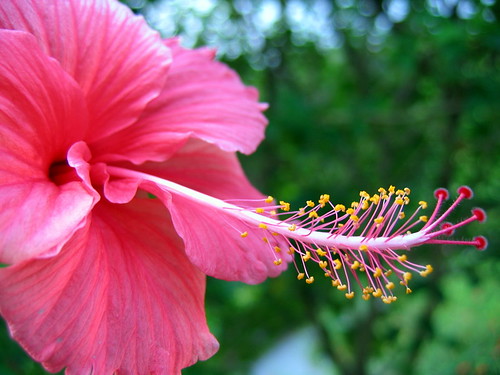Chinese Hibiscus Leaf Extract Increases Hair Growth in Mice

Hibiscus rosa-sinensis is traditionally used as a hair growth remedy. (Photo by williamnyk)
Hibiscus rosa-sinensis, also known as Chinese hibiscus or China rose, is cultivated as an ornamental plant throughout the tropics. The flowers of the plant are edible and can be added to salads. Preparations made from the flowers are also reputed to have medicinal properties.
One of these properties is increasing hair growth, which is why a lot of hair growth products in India include extracts of Hibiscus rosa-sinensis. It is also said to help prevent greying hair.
The study
Much of the claims are based on tradition and anecdotal evidence instead of scientific studies. In a rather rare study, Adhirajan et al. tested the effects of two Hibiscus rosa-sinensis extracts, one made from leaves and one from flowers, on albino rats.
The extract was made by drying and powdering leaves and flowers of the plant, extracting them with petroleum ether and then mixing a gram of the extract in 100 ml of liquid paraffin. This produced the 1% active compound, which was topically applied on the backs of shaved mice.
Results
No difference in the number of hair follicles was observed between the treated and control groups. Thus, the extract didn't grow any new hairs.
However, the hair growth cycles of the rats treated with the extract were significantly different from those in the control group. After 30 days, the anagen/telogen ratio of hair follicles was 50/50 in the control group, 54/46 in the placebo group, 60/40 in the flower extract group, and 67/33 in the leaf extract group.

In other words, after a month of applying the leaf extract, 67% of the hair follicles were in the anagen (growth) phase, whereas in the control group only 50% were in the anagen phase.
The length of hair was also higher in the treated rats. After 30 days, the average length of hair in millimeters was 13.6 in the control group, 14.5 in the placebo group, 15.8 in the flower extract group, and 17.0 in the leaf extract group.

Looking at the graph, the effect on hair length doesn't seem as dramatic as the effect on hair growth cycles. Still, compared to the control group, the leaf extract group showed a 25% increase in hair length, which isn't bad at all. Hair follicle length was also significantly increased the leaf extract group in vitro.
The above picture shows an initially shaved albino rat (e), a control group rat after 30 days (f), and a rat treated with leaf extract after 30 days (g).
Conclusion
The leaf extract of Hibiscus rosa-sinensis increases hair length and the anagen/telogen ratio of hair follicles in mice. The flower extract showed similar but more modest increases. Therefore, extracts made from the leaves of the plant are a possible hair growth remedy.
For more information on hair growth, see these posts:
How I Accidentally Grew Hair on My Left Temple with Retinol
Mixture of 5-Aminolevulinic Acid and Iron Increases Hair Growth in Mice
Vitamin E Tocotrienols May Grow Hair in Humans
Green Tea Extract Grows Hair in Vitro, Might Work in Vivo









3 kommenttia:
hello. can you explain more about the experiment? and what did you use for the placebo?
@zati,
I didn't do any experiments myself, this post is about a published paper. I think they used liquid paraffin for the control, but I can't remember anymore.
- JLL
I wonder.. can the leaf extract turns vellus hair to terminal hair?
Post a Comment